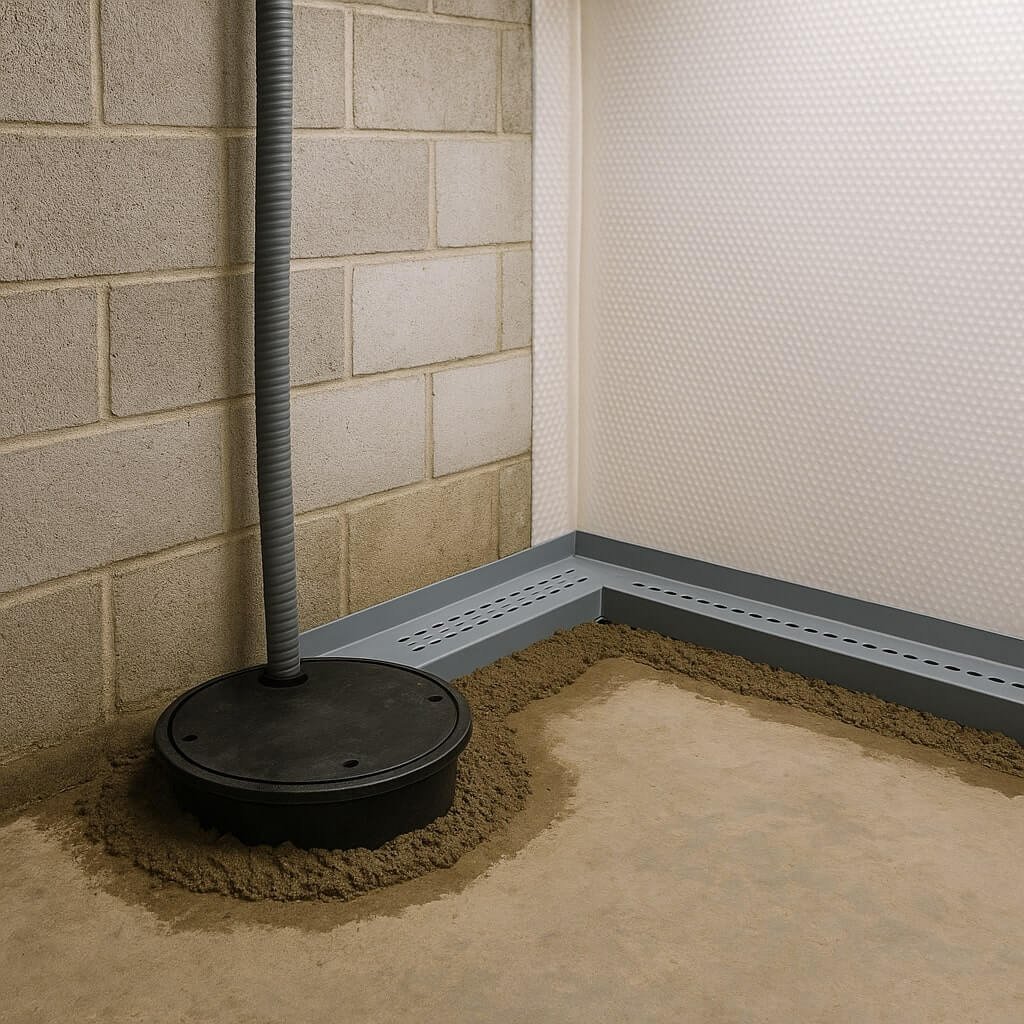When considering how much it costs to waterproof a basement, you need to account for several key factors. Size, methods, and local labor rates all play significant roles in determining the final price. Interior waterproofing can range from $1,000 to $4,500, while exterior solutions often come with a higher price tag. Understanding these variables will help you make informed decisions, but there are still many aspects to explore before you start your project.
Key Takeaways
- Waterproofing costs vary based on basement size, with larger spaces requiring more materials and labor.
- Interior drainage systems typically range from $1,000 to $4,500, depending on complexity.
- Sump pump installation costs usually fall between $800 and $2,500.
- DIY waterproofing materials can cost between $50 and $500, but may require additional tools.
- Hiring professionals may incur higher upfront costs but often ensures better long-term results and fewer unexpected expenses.
Understanding Basement Waterproofing
Waterproofing your basement is essential for maintaining a dry and healthy living space. To combat basement moisture, you’ll need to understand various waterproofing materials available.
These materials include sealants, membranes, and drainage systems designed to prevent water intrusion. Sealants, often applied to interior walls, block moisture from penetrating. Membranes, typically used on exterior surfaces, create a barrier against water.
Additionally, proper drainage systems, like sump pumps and French drains, redirect water away from your foundation. By selecting the right combination of waterproofing materials, you can effectively safeguard your basement against moisture and guarantee a more comfortable living environment.
Factors Affecting Waterproofing Costs

When considering basement waterproofing, several key factors influence the overall cost.
The size of your basement plays a significant role, as larger spaces require more materials and labor.
Additionally, the type of waterproofing method you choose and local labor costs can greatly affect your budget.
Basement Size Considerations
Choosing the right waterproofing solution often hinges on your basement’s size, as larger spaces typically require more materials and labor, which increases costs.
When evaluating your basement dimensions, consider how much space utilization you’ll need. A smaller basement might only require localized treatments, while a larger area demands thorough solutions to manage moisture effectively.
Additionally, the layout can influence labor intensity; tight spaces may complicate access, driving up costs further.
Understanding your basement’s size and how you plan to use the space will help you budget appropriately for waterproofing, ensuring you allocate resources efficiently without overspending.
Type of Waterproofing Method
Several factors influence the cost of your basement waterproofing method, and understanding these can help you make informed decisions. The type of waterproofing you choose—like interior sealing or drainage systems—greatly affects your budget. Here’s a quick comparison:
| Method | Cost Estimate | Effectiveness |
|---|---|---|
| Interior Sealing | $1,500 – $3,000 | Moderate |
| Interior Drainage | $2,000 – $5,000 | High |
| Exterior Drainage | $5,000 – $15,000 | Very High |
| Sump Pump Installation | $1,000 – $4,000 | Moderate to High |
Choose wisely based on your specific needs and budget constraints.
Local Labor Costs
The cost of waterproofing your basement isn’t just determined by the method you select; local labor costs play a significant role as well.
Factors affecting these costs include:
- Local contractor rates: Skilled labor prices vary by location, impacting overall expenses.
- Regional price variations: Urban areas often have higher labor costs compared to rural regions, reflecting demand and living costs.
- Experience level: Contractors with extensive experience or specialized skills may charge more, but they typically deliver better results.
Understanding these factors will help you budget more accurately for your basement waterproofing project.
Different Waterproofing Methods
Waterproofing methods vary markedly in their approach and effectiveness, allowing homeowners to select the best solution based on their specific needs. Common techniques include interior and exterior waterproofing, each having distinct features. Interior methods often use moisture barriers and sump pumps, while exterior solutions focus on enhancing basement drainage.
| Method | Description |
|---|---|
| Interior Waterproofing | Utilizes moisture barriers and drainage systems to prevent water from entering. |
| Exterior Waterproofing | Enhances basement drainage by installing a drainage system outside the foundation. |
| Sealants | Applies waterproof sealants to walls and floors to block water infiltration. |
Cost Breakdown of Interior Waterproofing

While evaluating your options for interior waterproofing, it’s essential to understand the associated costs to make an informed decision.
The overall expense will depend on various factors, including the chosen waterproofing techniques and interior materials.
The total cost will vary based on selected waterproofing methods and the materials used.
Here’s a breakdown:
- Surface Sealants: Ranging from $0.50 to $2.00 per square foot, these materials provide a basic moisture barrier.
- Interior Drainage Systems: Expect to pay between $1,000 and $4,500, depending on the complexity of installation.
- Sump Pumps: Installation costs typically range from $800 to $2,500, depending on the system’s capacity and features.
These costs can help you budget effectively.
Cost Breakdown of Exterior Waterproofing
When considering exterior waterproofing, understanding the costs involved is essential for effective planning. Below is a breakdown of key components that contribute to the overall expense.
| Component | Estimated Cost | Description |
|---|---|---|
| Exterior Sealants | $1,000 – $3,000 | Protects walls from moisture |
| Drainage Systems | $2,500 – $6,000 | Manages water flow away from home |
| Excavation | $1,500 – $4,000 | Necessary for installation |
| Labor Costs | $50 – $150/hour | Professional installation fees |
DIY Waterproofing vs. Professional Services
When considering waterproofing your basement, you’ll need to weigh the cost of DIY methods against the benefits of hiring professionals.
DIY solutions can save you money upfront, but they often require significant time and expertise to execute properly.
On the other hand, professional services offer specialized knowledge and equipment that can guarantee a more effective and long-lasting waterproofing solution.
Cost of DIY Methods
Choosing between DIY waterproofing methods and hiring professional services involves understanding the costs associated with each option.
DIY waterproofing techniques can provide cost-effective solutions but require effort and knowledge. Here are some potential costs you might encounter:
- Materials: Expect to spend $50-$500 on sealants, membranes, and drainage systems.
- Tools: If you don’t own the necessary tools, budget around $100-$300 for purchases or rentals.
- Time: Factor in the time investment, which could range from a weekend to several weeks, depending on the project’s complexity.
Ultimately, weigh these costs against the benefits of professional help for the best outcome.
Benefits of Professional Help
Opting for professional waterproofing services can greatly enhance the effectiveness and durability of your basement protection.
Experienced contractors bring advanced waterproofing techniques that DIY methods often lack, ensuring thorough coverage against water intrusion. They assess your specific situation, identifying problem areas you might overlook.
With proper contractor qualifications, you gain access to specialized tools and materials that guarantee better results. Professionals also offer warranties, giving you peace of mind about their work.
While DIY might save money upfront, the long-term benefits of professional help in preventing costly damage far outweigh initial savings, making it a wise investment for your home.
Signs Your Basement Needs Waterproofing
If you’ve noticed persistent dampness or musty odors in your basement, it’s likely time to contemplate waterproofing.
Here are three signs to be aware of:
Be vigilant for these three signs of moisture issues in your basement.
- Visible Mold or Mildew: This indicates excess moisture and can pose health risks.
- Cracks in Walls or Floors: Structural damage often suggests basement leaks, allowing water intrusion.
- Water Stains: Discoloration on walls or floors is a clear sign of moisture detection issues.
Ignoring these signs can lead to more severe problems, so addressing them promptly with waterproofing solutions is essential for maintaining a safe and dry environment.
Long-Term Benefits of Waterproofing
When you invest in waterproofing your basement, you’re not just addressing current moisture issues; you’re also securing your home’s long-term integrity.
Effective moisture control prevents structural damage, mold growth, and pest infestations, which can all compromise your home’s health. By reducing these risks, you enhance your property’s longevity and appeal.
Additionally, a waterproofed basement considerably contributes to increased home value, making it more attractive to potential buyers. Buyers often seek homes with proven moisture solutions, knowing they’ll save on future repairs.
Ultimately, waterproofing is a smart investment that safeguards your home and enhances its marketability.
Potential Hidden Costs
When waterproofing your basement, you might encounter hidden costs that can greatly affect your budget.
Unforeseen structural repairs, necessary permitting and inspection fees, and water damage remediation costs can all add up quickly.
It’s essential to take these factors into account to avoid financial surprises down the line.
Unforeseen Structural Repairs
While planning your basement waterproofing project, it’s essential to account for unforeseen structural repairs that may arise unexpectedly during the process.
These repairs can notably impact your budget and foundation stability. Here are three potential issues to watch for:
- Cracked Foundation Walls – These may need reinforcing or sealing to prevent further damage.
- Water Damage – Hidden mold or deterioration might require remediation, adding to unexpected expenses.
- Soil Erosion – This can compromise structural integrity and may necessitate additional drainage solutions.
Being proactive about these possibilities can save you from costly surprises down the line.
Permitting and Inspection Fees
Addressing unforeseen structural repairs can lead to additional expenses, but don’t overlook permitting and inspection fees, which often catch homeowners off guard.
Before you start waterproofing your basement, familiarize yourself with local permitting requirements; many municipalities require permits for such work. This means you’ll need to submit plans and pay fees, which can vary considerably.
Additionally, prepare for inspection processes that guarantee your work complies with building codes. Failing to account for these costs can inflate your budget unexpectedly.
Always check with local authorities to avoid surprises and guarantee a smooth project completion.
Water Damage Remediation Costs
Water damage remediation can greatly impact your overall basement waterproofing budget, often revealing hidden costs that homeowners overlook.
Here are three potential hidden costs to evaluate:
- Mold Removal: If water damage leads to mold growth, specialized remediation techniques can cost you hundreds to thousands of dollars.
- Structural Repairs: Damage to beams or walls may require significant repairs, which can escalate your expenses quickly.
- Content Restoration: Salvaging furniture or belongings affected by water damage often involves additional costs for cleaning and restoration services.
Being aware of these factors can help you better prepare for unexpected expenses during the remediation process.
Choosing the Right Waterproofing Contractor
When selecting a waterproofing contractor, it’s essential to take into account their experience and qualifications to guarantee your basement receives the best protection possible.
Look for contractors who’ve relevant certifications and a proven track record in basement waterproofing.
Don’t forget to check customer reviews; they offer valuable insights into the contractor’s reliability and workmanship.
Ask for references and consider contacting previous clients to discuss their experiences.
Ascertain the contractor provides a detailed plan and transparent pricing.
Conclusion
In summary, waterproofing your basement is an essential investment that can protect your home from water damage and mold. By understanding the various methods and associated costs, you can make informed decisions tailored to your needs. Don’t forget to factor in potential hidden costs and choose a reputable contractor to guarantee quality work. By taking these steps, you’ll enhance your home’s value and longevity while safeguarding your living space from moisture-related issues.




